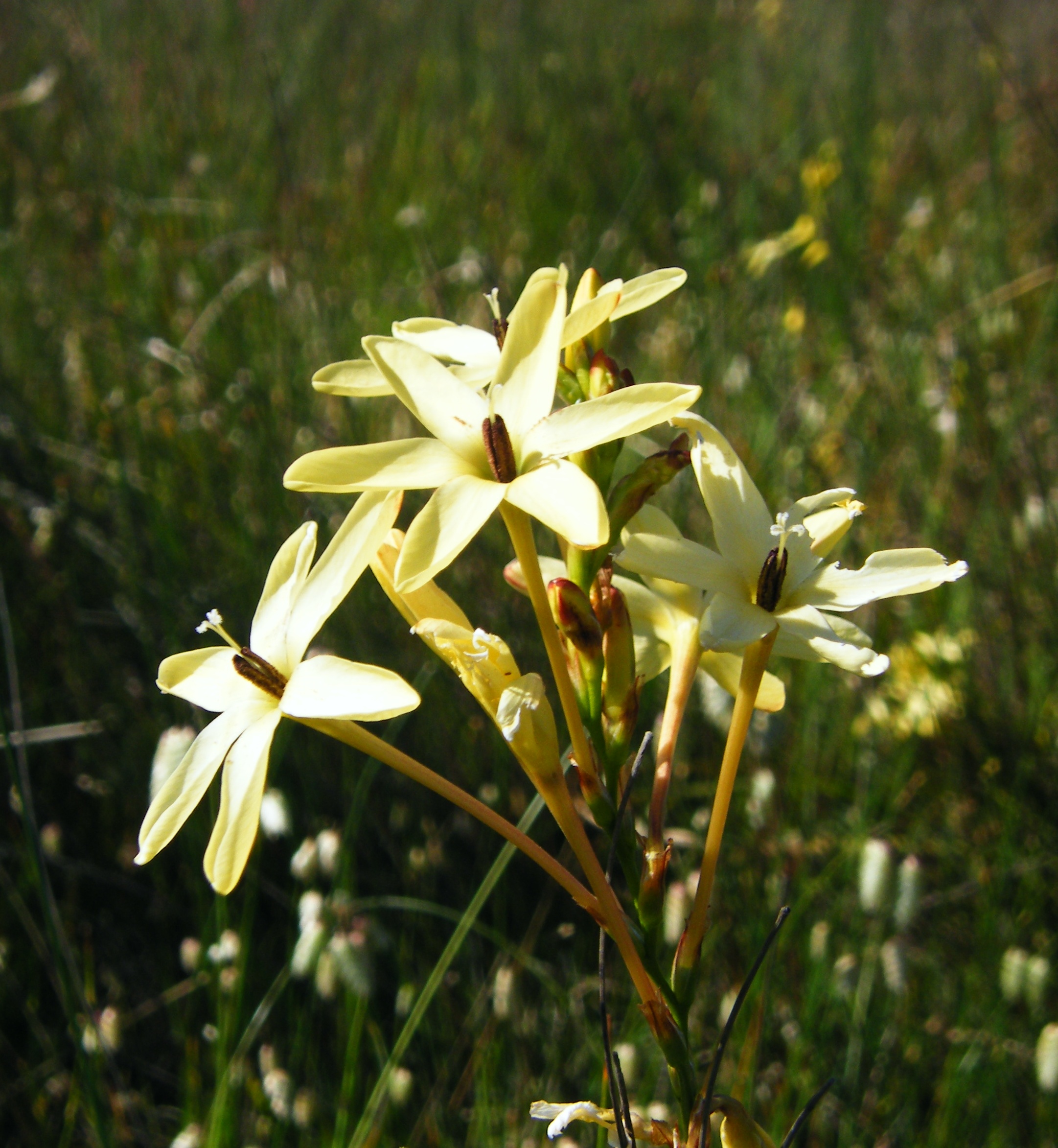Wandflower
(Ixia paniculata)

Description
Ixia paniculata, commonly known as the Wandflower, is an exquisite flowering plant that belongs to the Iridaceae family. Native to the Cape Floral Kingdom in South Africa, this species captivates botanists, horticulturists, and flower enthusiasts with its stunning beauty and unique characteristics. Its delicate, star-shaped flowers, tall inflorescence, and vibrant colors make Ixia paniculata a prized addition to gardens and floral displays worldwide. In this article, we will delve into the various aspects of Ixia paniculata, including its taxonomy, morphology, habitat, cultivation, and significance in horticulture. Taxonomy and Classification Ixia paniculata is classified under the genus Ixia, which is a diverse group of flowering plants encompassing approximately 50 species. The genus name "Ixia" is derived from the Greek word "ixios," which means "birdlime" or "sticky." This name refers to the sticky nature of the plant's sap. Within the genus Ixia, Ixia paniculata falls under the section Stenogynandrum, characterized by species that possess relatively narrow and pointed perianth segments. Morphology Ixia paniculata exhibits a striking appearance that sets it apart from many other flowering plants. The plant typically grows from a corm, an underground storage organ, and produces long, slender, and erect stems that can reach heights of up to 50 centimeters (20 inches). The lanceolate leaves of Ixia paniculata are narrow and grass-like, forming a basal rosette. The inflorescence is a wand-like spike, densely packed with numerous small flowers, arranged in a panicle or raceme. Flowers: The true charm of Ixia paniculata lies in its exquisite flowers. Each flower consists of six petals, collectively referred to as perianth segments. These segments are delicately shaped like stars and can display a wide range of colors, including shades of purple, pink, blue, and white. The throat of the flower often exhibits a contrasting hue or a dark center, adding to its visual appeal. Ixia paniculata flowers are radially symmetrical and have a tubular structure. Habitat and Distribution Ixia paniculata is endemic to the Cape Floral Kingdom, a biodiversity hotspot in South Africa renowned for its rich plant diversity. Within this region, the species is primarily found in the Western Cape Province, where it thrives in well-drained sandy or loamy soils. It typically grows in full sun or partial shade, often in rocky outcrops or grassy slopes. The Mediterranean climate of the area, characterized by cool, wet winters and hot, dry summers, is well-suited for the growth and flowering of Ixia paniculata. Cultivation Due to its captivating beauty, Ixia paniculata has gained popularity among horticulturists and gardening enthusiasts around the world. Cultivating this species can be a rewarding experience, but it requires specific growing conditions to ensure its successful growth and flowering. Climate: Ixia paniculata thrives in Mediterranean climates or regions with similar weather patterns. It prefers mild, wet winters and hot, dry summers. Soil: Well-drained sandy or loamy soils are ideal for Ixia paniculata. The soil should be moderately fertile and enriched with organic matter to promote healthy growth. Sunlight: This species prefers full sun to partial shade. Adequate sunlight is crucial for the development of robust flower spikes. Watering: Ixia paniculata should be watered regularly during the growing season, especially when the soil becomes dry Watering: Ixia paniculata should be watered regularly during the growing season, especially when the soil becomes dry. However, it is essential to avoid overwatering, as excessive moisture can lead to bulb rot. Providing a moderate amount of water, allowing the soil to dry slightly between waterings, is recommended. Fertilization: To support healthy growth and abundant flowering, it is beneficial to provide a balanced, water-soluble fertilizer during the active growth period. A fertilizer with a ratio of nitrogen (N), phosphorus (P), and potassium (K) of 10-10-10 or 5-10-10 can be applied every three to four weeks. Dormancy: After the flowering period, Ixia paniculata enters a dormant phase. During this period, the foliage gradually dies back. It is crucial to reduce watering during dormancy to prevent bulb rot. The dormant corms can be left in the ground or lifted, stored, and replanted the following season. Propagation: Ixia paniculata can be propagated through seeds or by dividing the corms. Seeds can be sown in well-drained soil during spring, and the young seedlings can be transplanted once they are large enough to handle. Corms can be carefully divided during the dormant season, ensuring that each division has viable roots and shoots. These divisions can then be replanted in suitable soil. Significance in Horticulture Ixia paniculata holds significant value in horticulture, both as a garden plant and as a cut flower. Its captivating flowers and slender inflorescence make it an excellent addition to flower beds, borders, and rock gardens. It pairs well with other spring and summer-flowering plants, adding a touch of elegance and color to the landscape. Furthermore, Ixia paniculata is highly valued as a cut flower, used in floral arrangements and bouquets. Its long, sturdy stems and vibrant flowers make it a sought-after choice for florists and flower enthusiasts. Conservation As a native species of the Cape Floral Kingdom, Ixia paniculata faces various threats in its natural habitat. Urbanization, habitat destruction, and invasive species pose significant challenges to the survival of this species. Additionally, climate change and habitat fragmentation further exacerbate the risks faced by Ixia paniculata and other endemic plants of the region. Efforts are being made to conserve the biodiversity of the Cape Floral Kingdom, including the protection of natural areas and the cultivation of indigenous plants in botanical gardens and horticultural programs. Conclusion Ixia paniculata, with its enchanting flowers and graceful presence, stands as a symbol of beauty and uniqueness. Its slender inflorescence, delicate star-shaped flowers, and vibrant colors make it a showstopper in gardens and floral displays. By understanding its taxonomy, morphology, habitat, and cultivation requirements, we can appreciate and conserve the splendor of Ixia paniculata, ensuring its presence and enjoyment for generations to come.
Taxonomic tree:







